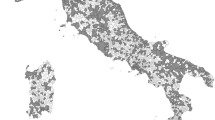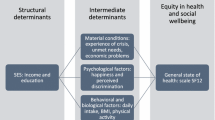Abstract
Objectives
This study explores the contribution of social relations to explain inequalities in self-rated health in a changing north-eastern German region. So far, there are only few studies that analysed the mediating effects of social relations in a longitudinal design.
Methods
We used data from the Study of Health in Pomerania (SHIP) consisting of 3,300 randomly selected men and women at baseline (2001), and at the 5-year follow-up (2006). Indicators of social inequality were education, equivalent household income and occupational status. Social relations were estimated by the Social Integration Index (SII) and the perceived instrumental and emotional support. Self-rated general health was assessed at both waves of data collection.
Results
Depending on the indicators used, social relations explain up to 35% of the inequalities in self-rated health. Changes in odds ratios are slightly more pronounced when education and income are used as inequality indicator and when adjusting for the SII.
Conclusions
Overall findings suggest that social relations are an important explanatory factor for health inequalities in a deprived German region.
Similar content being viewed by others
References
Bambra C, Pope D, Swami V, Stanistreet D, Rescan A, Kunst A, Scott-Samuel A (2009) Gender, health inequalities and welfare state regimes: a cross-national study of 13 European countries. J Epidemiol Community Health 63:38–44
Baron RM, Kenny DA (1986) The moderator–mediator variable distinction in social psychological research: conceptual, strategic, and statistical considerations. J Pers Soc Psychol 51:1173–1182
Baumeister SE, Alte D, John U (2004) Inanspruchnahme medizinischer Leistungen: Welche Rolle spielt die soziale Unterstützung?—Ergebnisse der Study of Health in Pomerania (SHIP) [Medical services utilisation. Which role does social support play?—Results from the Study of Health in Pomerania (SHIP)]. Gesundheitswesen 66:175–179
Berkman LF, Glass T (2000) Social integration, social networks, social support, and health. In: Berkman LF, Kawachi I (eds) Social epidemiology. University Press, Oxford, pp 137–173
Berkman LF, Syme SL (1979) Social networks, host resistance, and mortality: a nine-year follow-up study of Alameda County residents. Am J Epidemiol 109:186–204
Berkman LF, Melchior M, Chastang JF, Niedhammer I, Leclerc A, Goldberg M (2004) Social integration and mortality: a prospective study of French employees of Electricity of France-Gas of France: the GAZEL cohort. Am J Epidemiol 159:167–174
Cohen S (2004) Social relationships and health. Am Psychol 59:676–684
DeSalvo KB, Bloser N, Reynolds K, He J, Muntner P (2006) Mortality prediction with a single general self-rated health question. A meta-analysis. J Gen Intern Med 21:267–275
Destatis (ed) (2002) Datenreport 2002. Zahlen und Fakten über die Bundesrepublik Deutschland. Bonn
Destatis (2010) Arbeitsmarktstatistik der Bundesagentur für Arbeit. https://www.regionalstatistik.de/genesis/online;jsessionid=5173472A9870D80701F9DFAFBBCA18F1?sequenz=statistikTabellen&selectionname=13211. Accessed 25 August 2011
Destatis and WZB (ed) (2011) Datenreport 2011. Ein Sozialbericht für die Bundesrepublik Deutschland. Band I. Bonn
Fendrich K, Hoffmann W (2007) More than just aging societies: the demographic change has an impact on actual numbers of patients. J Public Health 15:345–351
Ganzeboom HBG, Treiman DJ (1996) Internationally comparable measures of occupational status for the 1988 International Standard Classification of Occupations. Soc Sci Res 25:201–239
Gorman BK, Sivaganesan A (2007) The role of social support and integration for understanding socioeconomic disparities in self-rated health and hypertension. Soc Sci Med 65:958–975
Haring R, Alte D, Völzke H, Sauer S, Wallaschofski H, John U et al (2009) Extended recruitment efforts minimize attrition but not necessarily bias. J Clin Epidemiol 62:252–260
Holahan CK, Holahan CJ (1987) Self-efficacy, social support, and depression in aging: a longitudinal analysis. J Gerontol 42:65–68
Holt-Lunstad J, Smith TB, Layton JB (2010) Social relationships and mortality risk: a meta-analytic review. PLoS Med 7:e1000316
House JS, Landis KR, Umberson D (1988) Social relationships and health. Science 241:540–545
Huisman M, Kunst AE, Mackenbach JP (2003) Socioeconomic inequalities in morbidity among the elderly; a European overview. Soc Sci Med 57:861–873
Idler EL, Benyamini Y (1997) Self-rated health and mortality: a review of twenty-seven community studies. J Health Soc Behav 38:21–37
John U, Greiner B, Hensel E, Ludemann J, Piek M, Sauer S et al (2001) Study of Health in Pomerania (SHIP): a health examination survey in an east German region: objectives and design. Soz Praventivmed 46:186–194
Kim DS, Jeon GS, Jang SN (2010) Socioeconomic status, social support and self-rated health among lone mothers in South Korea. Int J Public Health 55:551–559
Latzitis N, Sundmacher L, Busse R (2011) Regionale Unterschiede der Lebenserwartung in Deutschland auf Ebene der Kreise und kreisfreien Städte und deren möglichen Determinanten [Regional differences in life expectancy in Germany at county levels and their possible determinants.]. Gesundheitswesen 73:217–228
Macintyre S, Maciver S, Sooman A (1993) Area, class and health: should we be focussing on places or people? J Soc Policy 22:213–234
Mackenbach JP, Bos V, Andersen O, Cardano M, Costa G, Harding S et al (2003) Widening socioeconomic inequalities in mortality in six Western European countries. Int J Epidemiol 32:830–837
Mackereth C, Appleton J (2008) Social networks and health inequalities: evidence for working with disadvantaged groups. Community Pract 81:23–26
MacKinnon DP, Dwyer JH (1993) Estimating mediated effects in prevention studies. Eval Rev 17:144–158
Malmström M, Johansson SE, Sundquist J (2001) A hierarchical analysis of long-term illness and mortality in socially deprived areas. Soc Sci Med 53:265–275
Marmot MG, Bosma H, Hemingway H, Brunner E, Stansfeld S (1997) Contribution of job control and other risk factors to social variations in coronary heart disease incidence. Lancet 350:235–239
Matthews S, Manor O, Power C (1999) Social inequalities in health: are there gender differences? Soc Sci Med 48:49–60
Melchior M, Berkman LF, Niedhammer I, Chea M, Goldberg M (2003) Social relations and self-reported health: a prospective analysis of the French Gazel cohort. Soc Sci Med 56:1817–1830
Nebelung C, Forkel JA, Elkeles T (2010) Alltägliche Lebensführung und Solidarität in nordostdeutschen Landgemeinden—Erste qualitative Ergebnisse der Landgesundheitsstudie [Everyday life and solidarity in north-east German rural communities—first qualitative results of the rural health study]. Gesundheitswesen 72:140–145
Nieminen T, Martelin T, Koskinen S, Aro H, Alanen E, Hyyppä MT (2010) Social capital as a determinant of self-rated health and psychological well-being. Int J Public Health 55:531–542
Nolte E, McKee M (2004) Changing health inequalities in east and west Germany since unification. Soc Sci Med 58:119–136
Power C, Matthews S, Manor O (1998) Inequalities in self-rated health: explanations from different stages of life. Lancet 351:1009–1014
Reichert-Schick A (2008) Siedlungsregression und Schrumpfungsprozesse ländlicher Gemeinden in Vorpommern [Settlement regression and shrinkage process of rural communities]. Eur Reg 16:36–48
Saltzman KM, Holahan CJ (2002) Social support, self-efficacy, and depressive symptoms: an integrative model. J Soc Clin Psychol 21(3):309–322
Sherbourne CD, Stewart AL (1991) The MOS social support survey. Soc Sci Med 32:705–714
Siegrist J, Marmot M (eds) (2006) Social inequalities in health. New evidence and policy implications. Oxford University Press, New York
Skalicka V, van Lenthe F, Bambra C, Krokstad S, Mackenbach J (2009) Material, psychosocial, behavioural and biomedical factors in the explanation of relative socio-economic inequalities in mortality: evidence from the HUNT study. Int J Epidemiol 38:1272–1284
Stansfeld SA, Head J, Marmot MG (1998) Explaining social class differences in depression and well-being. Soc Psychiatry Psychiatr Epidemiol 33:1–9
Stansfeld SA, Head J, Fuhrer R, Wardle J, Cattell V (2003) Social inequalities in depressive symptoms and physical functioning in the Whitehall II study: exploring a common cause explanation. J Epidemiol Community Health 57:361–367
Statistisches Amt Mecklenburg Vorpommern (2009). Bevölkerung, Haushalte, Familien, Fläche. http://www.statistik-mv.de/cms2/STAM_prod/STAM/de/bhf/index.jsp. Accessed 25 August 2011
Turner RJ, Marino F (1994) Social support and social structure: a descriptive epidemiology. J Health Soc Behav 35:193–212
Voigtlander S, Berger U, Razum O (2010) Zunehmende regionale Unterschiede bei den Lebensverhältnissen in Deutschland und ihre Bedeutung für die Erklärung gesundheitlicher Ungleichheit [Increasing regional disparities in living conditions in Germany and their role in the explanation of health inequalities]. Gesundheitswesen 72:301–308
Völzke H, Alte D, Schmidt CO, Radke D, Lorbeer R, Friedrich N et al (2011) Cohort profile: the study of health in Pomerania. Int J Epidemiol 40:294–307
von dem Knesebeck O (2005) Die Bedeutung sozialer Beziehungen für den Zusammenhang zwischen sozialer Ungleichheit und Gesundheit im Alter [The importance of social relationships for the association between social inequality and health among the aged]. Soz Praventivmed 50:311–318
von dem Knesebeck O, Geyer S (2007) Emotional support, education and self-rated health in 22 European countries. BMC Public Health 7:272
Weyers S, Dragano N, Möbus S, Beck EM, Stang A, Möhlenkamp S et al (2008) Low socio-economic position is associated with poor social networks and social support: results from the Heinz Nixdorf Recall Study. Int J Equity Health 7:13
Weyers S, Dragano N, Möbus S, Beck EM, Stang A, Möhlenkamp S et al (2010) Poor social relations and adverse health behaviour: stronger associations in low socioeconomic groups? Int J Public Health 55:17–23
Wilkinson R, Marmot M (2003) Social determinants of health: the solid facts, 2nd edn. World Health Organization, Copenhagen
Acknowledgments
SHIP is part of the Community Medicine Net (http://medizin.uni-greifswald.de/icm) of the University of Greifswald funded by grants form the German Federal Ministry of Education and Research (BMBF, grant 01ZZ96030, 01ZZ0701). The contributions to data collection made by field workers, study physicians, ultrasound technicians, interviewers, and computer assistants are gratefully acknowledged. The authors would like to thank the German Research Council for funding the project ‘Health inequalities and social relationships’ (DFG, funding number KN 885/3-1).
Conflict of interest
The authors declare that they have no conflict of interest.
Ethical standards
The study was approved by the Ethics Committee of the University of Greifswald and complies with the current laws of the country.
Author information
Authors and Affiliations
Corresponding author
Rights and permissions
About this article
Cite this article
Klein, J., Vonneilich, N., Baumeister, S.E. et al. Do social relations explain health inequalities? Evidence from a longitudinal survey in a changing eastern German region. Int J Public Health 57, 619–627 (2012). https://doi.org/10.1007/s00038-012-0356-y
Received:
Revised:
Accepted:
Published:
Issue Date:
DOI: https://doi.org/10.1007/s00038-012-0356-y




